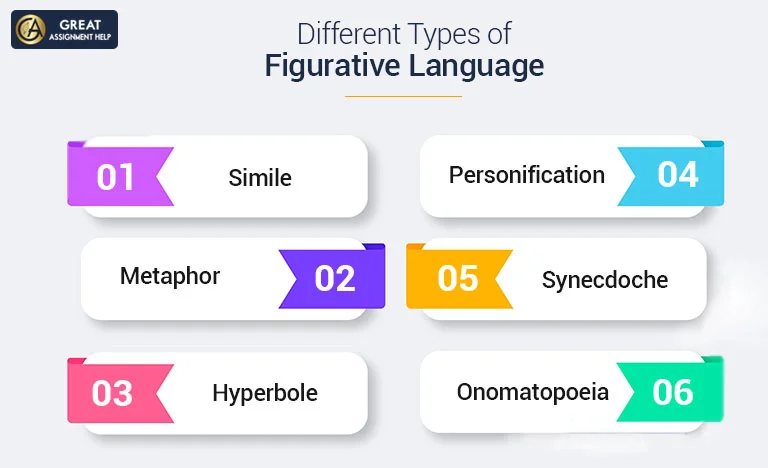Would you have to become an excellent creative writer or literary author? If yes, then instead of stating something by using an ordinary sentence, try to use figurative language or figures of speech in your writing. Basically, with figurative language, you can convey an idea or thought in a poetic manner. If you are unaware of what figurative language means, then continue reading this blog. Here, for your better understanding, we have explained in detail the definition, benefits, and different types of figurative language elements with examples.
What is Figurative Language?
Simply, figurative language makes use of words in a way such that it moves away from the modern order and meaning. Also, figurative language communicates a complex meaning, colorful writing, clarity, and evocative comparison. Moreover, it makes use of simple sentences to communicate something, without mentioning it directly. So, if you have read Management Discussion and Analysis, possibly the management will use metaphors and explain complex directions. Mostly, fictional writers use figures of speech to keep the audience engaged and use a creative tone to challenge thinking. Furthermore, it makes fictional writing more dramatic and interesting than literal language that uses words to convey statements.
Also, Read – What is Language Technique
Different Types of Figurative Language Elements
Now that you know what is figures of speech, let’s explore their types and how it’s relevant in a modern language.
Simile
- Firstly, the simile is a figure of speech that compares two different things and makes use of the words, “as” or “like”.
- Secondly, a smile is used to develop a sense of interest in the minds of the readers.
Example
“The cat sat in the chair like a king overlooking his kingdom”. To illustrate, the cat is compared to a king in this sentence, who is resting in a chair, just meant for him.
Let’s explore a few more examples of a simile as follows:
- The girl was as brave as a lion in the jungle.
- The new lecturer is as tall as a giraffe.
- The new aunty is as curious as a cat, nothing escapes her eyes.
Metaphor
- Like a Simile, a metaphor also compares two different things, however, it doesn’t make use of the words – as or like.
- Mostly, a metaphor makes sense only when the readers apprehend the connection between two things.
Example
“Time is money.” To illustrate, this sentence compares time to money, however, it doesn’t mean that time is equal to the money you have.
Let’s explore a few more examples:
- Love is a war zone.
- The warrior has a heart of stone.
- She is sinking into a sea of grief.
Hyperbole
- Simply, hyperbole is an exaggeration that is established to highlight a point or produce a sense of humor.
- Frequently, hyperbole is used in daily conversation, while the speaker doesn’t notice it.
- Meanwhile, the exaggeration is so outrageous that no one might believe it is true.
- In brief, hyperbole is used to add color and depth to a statement.
Example
“I can die for you.” Simply, here it doesn’t mean that one person would die for another person, instead, it implies the portrayal of deep love in the sentence.
Let’s explore a few more examples below:
- I have told you a million times to wash your face.
- He snores like a freight train.
- You are so slim that the wind can carry you.
Personification
- Generally, personification is the allocation of human characteristics to non-living objects.
- Besides, personification creates an impact on the way the readers imagine things and their interest develops in the subject.
Example
“Sun greeted me when I woke up in the morning.” As per this example, the Sun is a non-human object, but it is considered a human object because non-human objects can’t greet.
Let’s explore a few more examples as follows:
- The radio stared at me.
- April is the cruelest month of the year.
- The car stopped with a groaning complaint.
Synecdoche
- Simply, synecdoche is a figurative language that makes use of one part to relate to the entire part.
- Perhaps, it will also refer to the whole part to relate to one part.
For example, a set of wheels is used to refer to a vehicle, while a suit is used to refer to a businessman. Thus, when a set of wheels is used, it is referred to only a part of the vehicle and not the vehicle as a whole. Likewise, a typical businessman wears a suit along with other accessories like a briefcase or a watch.
Let’s explore a few more examples of the synecdoche as follows:
- The head might be referred to as counting people or even counting the cattle.
- Hired hands might refer to workers of an organization.
Onomatopoeia
- Generally, onomatopoeia is a language that provides names to a thing or an action by duplicating their sounds.
- Meanwhile, an onomatopoeia adds some reality to the writing.
Examples
- The truck engine roared as it climbed the hill.
- The fireplace heated hissed and cracked.
Uses of Figurative Language
Basically, with the help of figurative language, you can
- Compare two distinct concepts to improve comprehension.
- Clarify concepts that are difficult to comprehend.
- Demonstrate a more profound emotion or connection.
- Easily connect with the audience.
- Make visualization simpler and evoke a feeling in the mind of the audience.
Also, See – Language Features for You to Consider – An Essential Guide
Advantages of Figurative Language
- Simply, figurative language might help writers to enhance their literacy skills. Besides, figurative language communicates emotions as well as develops tones and moods. Perhaps, it demonstrates little nuances in connotation.
- Meanwhile, figurative language also makes a language more accessible for English language students.
- Finally, figurative language helps to generate rich and creative writing. Possibly, students who understand figurative language might easily develop into expert writers.
Conclusion
We hope you are now clear about what figurative language means and how to use it in your work. If you want to add a new shade to your piece of writing, then while framing a sentence, use the appropriate types of figurative language elements mentioned above. In case, you are still confused about how to do your assignments related to figurative language or if you are unaware of how to implement figurative language elements in your content, then without any hesitation, approach us.



